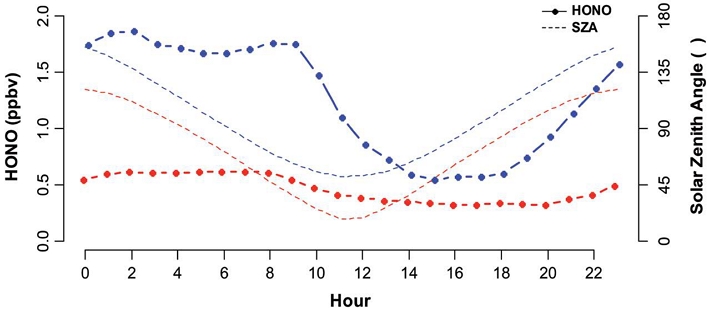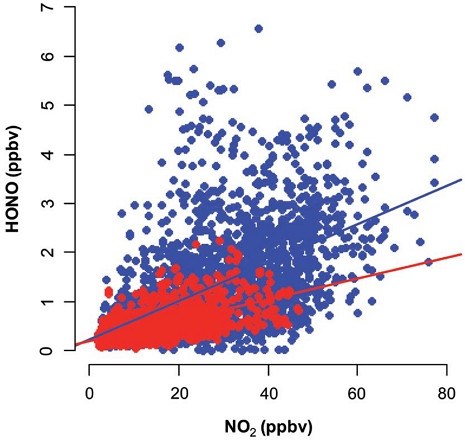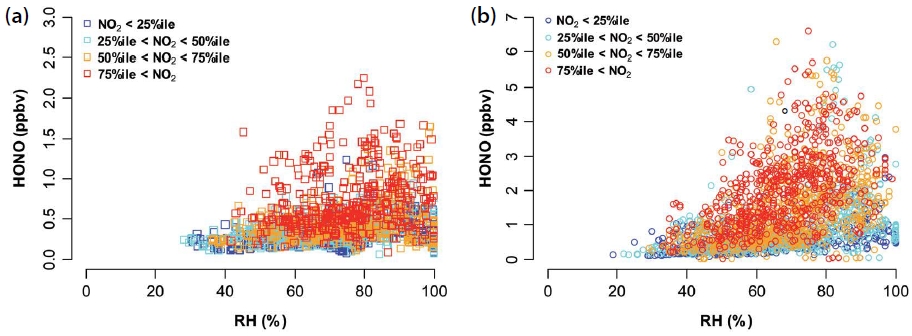
2021~2022년 서울 도심에서 측정된 HONO의 변화 특성
Abstract
HONO takes up a large amount of urban OH budget in the early morning through photolysis and is one of the major reactive nitrogen oxides (NOy) that finally contributes to the enhancement of daytime O3 and potentially PM2.5 nitrate (NO3-). Therefore, it is important to figure out the distribution and characteristics of HONO to understand the formation mechanisms of O3 and NO3- in urban areas. In this study, real-time HONO measurement was conducted in Seoul, South Korea from 2021 to 2022 using the MARGA (Monitor for AeRosol and Gases in Ambient air) system. During the whole measurement period, average concentration of HONO was 0.96 ppbv, and it was higher in the cold season when the NO2 concentration was high. Regardless of the season, HONO increased with an increase in NO2 and relative humidity, indicating that the HONO in Seoul was influenced by the heterogeneous formation. In addition, the impact of HONO on O3 was differed on the season, and HONO showed the possibility to contribute to the NO3- during both daytime and nighttime via formation-loss process.
Keywords:
Nitrous acid (HONO), O3, MARGA, PM2.5 nitrate (NO3-), Heterogeneous reaction1. 서 론
대기 중 인간활동에 의해 배출되는 질소산화물 은 대부분 NOx(=NO+NO2) 형태로 배출되며 이때 배출된 NOx의 산화과정을 통해 다양한 질소산화물 (NOz=HONO+HNO3+PAN+N2O5+…)을 형성한다 (Chan et al., 2021). 이 중 HONO는 짧은 수명 (lifetime)으로 인하여 NOx 배출이 많은 도시지역에서 주로 높게 나타나며, 주간에는 광분해반응을 통해 소멸되므로 야간에 주로 높은 농도를 보인다 (반응 1) (Alicke et al., 2003; Stutz et al., 2000; Stockwell and Calvert, 1978).
HONO의 광분해반응을 통해 생성되는 OH는 주로 이른 오전 시간 대기의 주요한 산화제 역할을 수행하며, 일간 OH 총 생성량의 최대 30%를 차지한다 (Ryan et al., 2018). 광분해반응을 통해 생성된 OH는 휘발 성 유기화합물 (Volatile Organic Compounds, VOCs)을 산화시키며, 결과적으로 주간 O3 증가에 기여한다 (Yang et al., 2021b; Gil et al., 2020; Kleffmann, 2007). 선행 연구에 따르면 서울의 O3 농도는 주로 VOCs 에 민감하며, HONO의 광분해를 통해 생성된 OH는 VOCs 산화기작을 통해 주간 O3 최고농도의 약 20%까지 기여할 수 있는 것으로 알려져 있다 (Gil et al., 2021; Kim et al., 2018a, 2018b). 따라서, 서울에서의 O3 생성 기작을 이해하고, 고농도 O3 발생 원인을 추적하는 데 있어 HONO의 농도를 파악하는 것은 매우 중요하다.
최근 연구에 따르면 서울에서 관측된 초미세먼지 (PM2.5) 질산염 (NO3-)에 반응 2를 통한 HNO3 생성 그리고 이질반응 (heterogeneous reaction)이 기여할 수 있다고 보고되었으며, 이때 HONO의 광분해로부터 비롯된 OH가 반응 2를 통해 NO3- 생성과정에 영향을 줄 수 있다 (Lim et al., 2022).
또한 역으로 NO3-의 광분해과정을 통해 HONO가 생성될 수 있는 결과도 보고되었다 (Andersen et al., 2023). 이러한 연구 결과들은 대기 중으로 배출된 NOx가 광화학반응을 통해 O3와 NO3-를 생성하고, 이러한 과정에서 HONO가 재사용되며 중요한 키 역할을 수행하고 있는 것을 의미한다. 또한 NO3-뿐만 아니라 이차유기에어로졸 (Secondary Organic Aerosol)의 생성에 대한 HONO의 기여 또한 보고됨에 따라, 국내 주요 대기오염물질인 O3와 초미세먼지의 전반적인 이해 및 관리에 있어 HONO의 분포 및 생성 특성을 파악하는 것이 요구된다 (Zhang et al., 2019a).
HONO의 생성은 일반적으로 NO와 OH의 반응을 통한 동질반응 (homogeneous reaction) 그리고 NO2와 H2O의 이질반응이 주요 생성 기작으로 알려져 있다. 동질반응을 통한 HONO 생성 기작은 주로 OH가 높은 주간에 활발하게 나타나나, 이때 생성된 HONO는 대부분 광분해반응을 통해 소멸된다 (Kurtenbach et al., 2001). 최근 연구에 따르면 도시지역에서 야간에도 OH 농도가 높아질 경우 이러한 동질반응을 통해 HONO가 생성될 수 있다는 결과가 보고되었다 (Zhang et al., 2019b; Tan et al., 2017).
이질반응을 통한 HONO 생성은 주로 야간 NO2 및 상대습도의 증가와 함께 나타나며, 이질반응의 특성상 도로나 지표, 건물 혹은 대기 중 입자 등의 표면을 필요로 하는 것으로 알려져 있다 (Bhattarai et al., 2021; Kim et al., 2021; Wen et al., 2019; Bao et al., 2018; VandenBoer et al., 2015). 특히 서울의 경우 높은 주거밀집도와 산지가 많은 지형적 특성 그리고 높은 미세먼지 농도 등 활성화 표면적 (active surface)에 관련된 요소가 다양하게 혼재되어 있으므로 HONO의 생성 기작을 이해하는 데 있어 이에 대한 연구가 필요하다.
본 연구에서는 MARGA (Monitor for AeRosols and Gases in Ambient air) 시스템을 도입하여 2021년 초여름부터 2022년 가을까지 약 2년에 걸쳐 대기 중 HONO를 관측하여 서울시 HONO의 분포 특성에 대해 파악하고자 하였다. 계절별 HONO 및 생성 전구체, 태양천정각 등의 비교를 통해 HONO 생성-소멸기작의 변화를 추적하였으며, HONO와 O3 및 PM2.5 NO3-와의 연관성에 대한 분석을 수행하였다.
2. 연구 방법
2. 1 HONO 및 반응성 미량기체 측정
2021년 5월~2022년 12월 동안 서울시 성북구에 위치한 고려대학교 메디힐 지구환경관 7층 (37.59°N, 127.03°E, 72 m asl.)에서 대기 중 미량기체 (O3, NO, NO2, NOy, HONO, HNO3)와 PM2.5 구성성분 (NO3-) 그리고 기상요소 (온도, 습도, 풍향, 풍속)를 실시간으로 측정하였다. O3 (49i, Thermo scientific.), NO2 (T500U, Teledyne API.), NO, NOy (T200U, Teledyne API.)는 각각 2분마다 측정하였으며 기상요소는 옥상에서 자동기상관측장비 (Automatic Weather System, AWS)를 이용하여 5분 간격으로 측정하였다.
HONO와 HNO3 그리고 PM2.5 NO3-는 Metrohm사의 MARGA 2060 R 시스템을 사용하여 측정하였다. 인렛 (Inlet)에서의 흡착으로 인한 시료의 손실을 막기 위해 PFA (Perfluoroalkoxy) 재질의 인렛을 사용하였으며 (Genfa et al., 2003; Neuman et al., 1999), PM2.5 입경 분리를 위해 인렛의 앞단에 PM2.5 임팩터를 설치하였다. 시료 포집을 위한 MARGA 시스템의 유량은 16.7 L min-1으로 설정하였으며, 기체상 시료의 포집은 습식회전디누더 (Wet-Rotating Denuder)에서, 입자상 시료의 포집은 습식회전디누더 뒤에 위치한 증기분사 에어로졸 포집기 (Steam-Jet Aerosol Collector)에서 수행되었다. 디누더를 사용한 기체상 HONO 시료 포집은 측정지역의 환경에 따른 간섭이 존재할 수 있다 (Xu et al., 2019). 측정기간 중 SO2의 평균농도는 약 2 ppbv로 SO2에 의한 간섭이 발생할 수 있는 고농도 SO2 환경 (약 23 ppbv 이상)에 해당하지 않으며 (Xue et al., 2019), 질소계열물질 (NO2, PAN 등) 간섭에 의한 HONO 농도 오차 (artifact)의 지표인 HNO3 평균농도 또한 0.1~0.3 ppbv로 매우 낮아 (Bari et al., 2003) 측정 환경에 의한 오차는 적었을 것으로 판단 된다. 해당 조건하에서 MARGA 시스템의 포집 효율은 99% 이상이며, HONO와 HNO3, NO3-의 검출한계는 각각 5 pptv, 2 pptv, 0.01 μg m-3이다 (Cowen et al., 2011). HONO, HNO3 그리고 NO3- 측정의 시간 해상도는 1시간이며, 모든 자료는 MARGA 시스템에서 산출한 자료의 시간 해상도에 맞추어 1시간 평균값을 사용하였다.
3. 결과 및 고찰
3. 1 HONO의 농도 분포 특성
전체 측정기간 중 HONO의 평균농도는 0.96 ppbv, 최고농도는 6.59 ppbv였다 (그림 1). 연도별로 평균농도를 비교하면 2021년과 2022년에 각각 1.05 ppbv, 0.9 ppbv로 자료의 개수가 동일하지 않았음에도 큰 차이가 나타나지 않았다. 월별 평균농도는 대체로 온도가 높은 (20.8±4.5°C) 5~6월 (0.47 ppbv)에 비해 온도가 낮은 (6.9±7.4°C) 10월~3월 (1.26 ppbv)에 높았으며, 이때 NO2 평균농도도 하절기 (12.9 ppbv)에 비해 동절기 (25.5 ppbv)에 높았다. HONO 측정 결과를 기존 선행 연구와 비교하였을 때, 북경이나 상해 등 대도시지역 (0.6~1.3 ppbv)과는 유사하였으며 (Gu et al., 2022; Lin et al., 2022; Wang et al., 2022), 교외지역 (0.2~0.6 ppbv)보다는 높았다 (Xue et al., 2022; Reed et al., 2016; Kim et al., 2015). 과거 서울의 측정 결과와 비교하였을 때 하절기의 HONO 농도는 유사하거나 비교적 낮았는데, 이는 그간 NO2의 농도 감소와 밀접한 관련이 있을 것으로 생각된다 (표 1). 그러나 배경지역인 백령도보다는 훨씬 높으므로, HONO는 도시의 고농도 NO2와 관련된 질소산화물임을 잘 나타낸다.
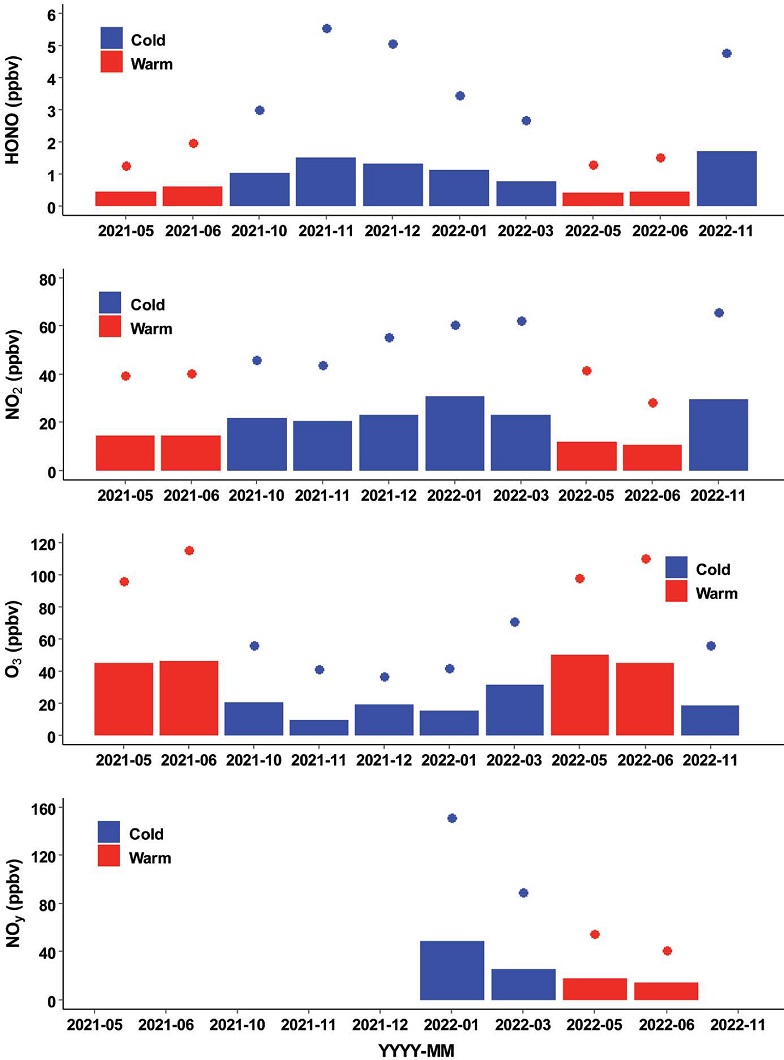
Monthly mean (box) and 99%ile (closed circle) concentration of HONO, NO2, O3, and NOy during the whole measurement period.

HONO measurements from previous studies conducted in South Korea. The NO2 mixing ratio is averaged value during measurement.
측정기간 중 2022년 1월과 3월 그리고 5월과 6월에 총 질소산화물 (NOy)을 측정하였고, 이를 기반으로 NOz (=NOy-NOx)를 추정하였다. NOz에 대한 HONO의 비중은 동절기에 약 18.0%였고, 하절기에는 약 14.4%로 감소했는데, 이러한 계절에 따른 변화는 도시지역 HONO가 NO2와 관련되어 있음을 잘 나타낸다. HONO 농도가 높은 야간 (17.2%)에는 주간 대비 (14.5%) HONO의 비중이 증가하였고, 특히 동절기의 경우 야간에는 20%까지 상승하였는데 이는 질소산화물 관리에 있어 HONO에 대한 지속적인 관측이 필요함을 보인다.
HONO는 광분해율이 높아 주간에 농도가 낮고 야간에 높은 뚜렷한 일변화 분포를 보인다. 계절별로는 태양천정각 (Solar Zenith Angle)의 변화로 인해 주간 HONO의 감소 및 야간 증가 시작 시간이 확연하게 변화하였다. (그림 2). HONO가 하절기에는 5~6시부터 감소하기 시작하였으나, 동절기에는 9시까지 고농도가 유지되었다. 또한 야간 HONO의 증가는 동절기에는 18시부터 나타났으나, 하절기에는 20시가 되어서야 나타나기 시작하였다. 이러한 계절에 따른 차이는 HONO가 광분해반응에 민감하며 광분해 시 OH의 공급원으로 작용 가능함을 시사한다.
3. 2 계절에 따른 HONO의 생성 특성
HONO는 야간에 주로 NOx의 이질반응에 의해 생성되는 것으로 알려져 있으며, 일반적으로 NO2와 높은 상관관계를 보인다. 실제로 계절과 상관없이 NO2와 HONO의 상관계수 (r)는 0.5~0.6으로 높았다 (그림 3). 또한 선행 연구에 따르면 차량으로부터 직접 배출 (direct emission)되는 HONO는 NO2 농도의 약 0.18~1.31%에 해당하는 것으로 추정된다 (Li et al., 2021a; Kramer et al., 2020; Liang et al., 2017; Liu et al., 2017; Trinh et al., 2017). 본 연구에서는 HONO가 NO2 농도의 4.4 (하절기)~5.2 (동절기)%를 차지하였으며, 선형회귀선의 기울기는 하절기에 0.02, 동절기에 0.04로 선행 연구에서 제시한 직접배출의 비율보다 크게 나타났다. 이러한 결과는 관측된 HONO가 직접배출에 의한 영향을 크게 받지 않았음을 지시한다.
선행 연구의 결과로 제시된 HONO의 이질반응 생성과정에 중요한 요소는 상대습도 (Relative Humidity, RH)로, 주간과 야간 모두 HONO 농도가 RH와 함께 증가하는 현상이 다수 보고되었다 (Cui et al., 2018; Huang et al., 2017; Li et al., 2012). 본 연구에서도 계절 및 일변화와 관계없이 RH가 증가하며 HONO가 증가하였으며, RH가 약 80% 이상인 조건에서는 오히려 HONO의 농도가 감소하는 경향을 보였다 (그림 4). 이러한 RH에 따른 HONO의 변화는 많은 선행 연구에서 보고되었으며 에어로졸 입자의 크기, 즉 표면적과 구성성분 등이 영향을 미치는 것으로 제시된 바 있으나, 아직 그 이유가 분명하게 밝혀지지는 않았다 (Gil et al., 2021; Liu et al., 2019; Wojtal et al., 2011). RH가 높을수록, 그리고 NO2 농도가 높을수록 HONO의 농도가 높았는데, 이는 서울에서 HONO가 대기 중 NO2의 이질반응에 의해 생성될 수 있음을 지시하며, 이러한 이질반응 과정을 이해하기 위해서는 질소산화물 전구기체와 더불어 입자상 물질에 대한 이해가 필요함을 제시한다.
3. 3 도시 대기 중 HONO의 영향
밤에 증가한 HONO는 이른 아침 광분해되어 OH를 생성하는데, 이는 O3 농도가 낮은 이른 오전 시간 OH의 주 공급원으로 VOCs를 산화시켜 O3 생성에 크게 기여하는 것으로 알려져 있다 (Yang et al., 2021a). 선행 연구에 따르면 HONO는 이러한 HONO-VOCs-O3 chain을 통해 HO2에는 약 39%까지, O3에는 일 최대농도의 약 20%까지 기여하는 것으로 보고되었다 (Gil, 2022; Li et al., 2021b; Jiang et al., 2020). 이로 인해 과거 서울에서 측정한 선행 연구에서는, 일변화 양상의 차이로 HONO와 O3 농도가 반비례하는 관계를 보이나, 일 최대농도는 양의 상관관계 (r=0.5~0.6) 를 갖는 것으로 나타났다 (Gil et al., 2021, 2020). 본 연구에서도 실제로 광화학반응이 활발한 5~6월에는 O3와 HONO의 일 최대농도가 양의 상관관계 (r=0.3, p-value<0.05)를 보였다 (그림 5). 그러나 NO2와 HONO가 높고 O3가 낮은 동절기에는 이러한 일 최고농도 사이의 상관성이 분명하지 않았다.
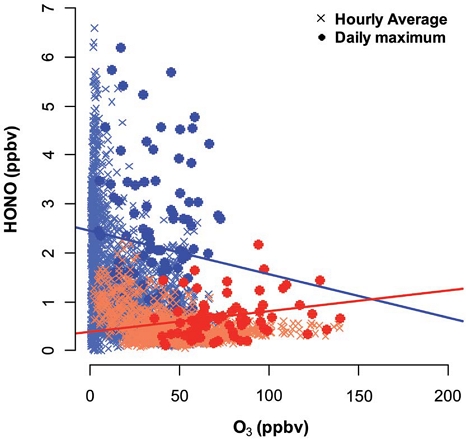
The relation between HONO and O3 during the warm season (red series) and the cold season (blue series). Cross marks indicate hourly averaged data and closed circles indicate the daily maximum of daytime O3 and nighttime HONO.
NO2 농도가 최대에 이르는 이른 아침 HONO의 광분해로 생성된 OH는 NO2를 HNO3로 산화시킬 수 있다 (반응 2). 특히 일출이 늦은 동절기에는 HONO는 NO2 농도가 최대가 되는 8시경까지 높게 유지되었다. HNO3가 생성된다면 결과적으로 NO3- 증가에 기여할 가능성도 있다. HNO3는 지표면 근처에서 침적의 영향이 매우 크고 (Xu and Matsuda, 2020) 기체-입자 동역학이 매우 역동적이므로 대부분 HNO3는 NO3-와 더불어 Total nitrate (TNO3=NO3-+HNO3)로 취급하는데, 실제 서울에서 관측된 TNO3의 일변화는 오전에 증가하기 시작하여 11시 근처에서 최댓값을 보였고 이후 NO2 농도의 감소와 함께 감소하였다 (그림 6). 열역학과정을 통한 질산염의 생성에는 상대습도가 매우 중요한 역할을 하는데 오전 시간은 상대습도가 급격하게 증가하므로 HONO를 통한 HNO3의 생성이 질산염 생성에 직접적으로 기여했음을 보이기는 어렵다. 하지만 HONO의 이질반응에 에어로졸 표면이 관여하듯, 서울에서는 오전 시간에 입자의 개수가 크게 증가하므로 입자를 매개로 한 이질반응의 역할을 추정해 볼 수 있다.
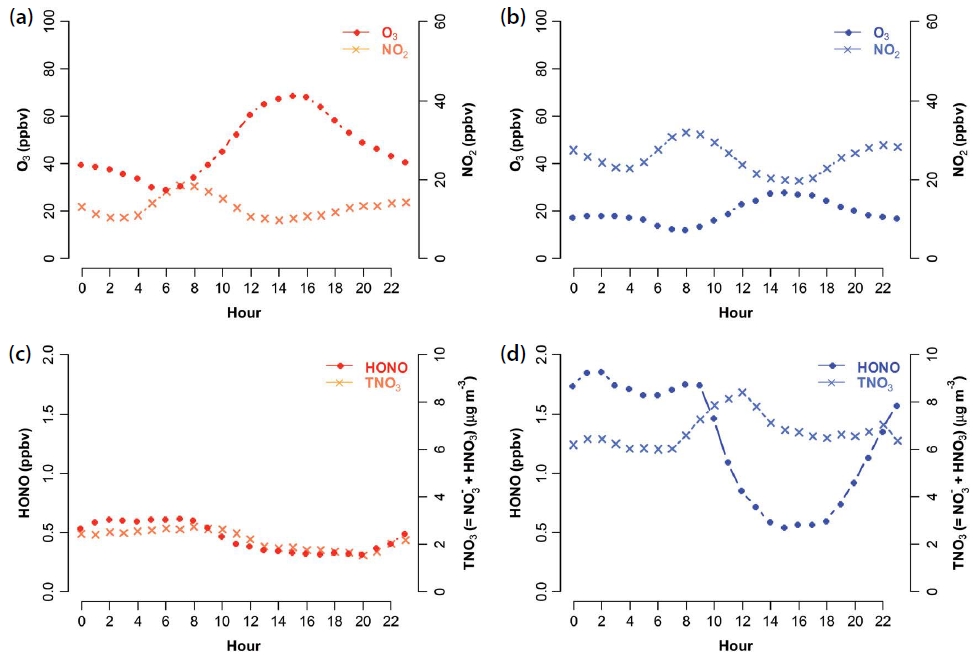
The diurnal variation of O3, NO2, HONO, and total nitrate (TNO3) during the ((a) and (c)) warm season and the ((b) and (d)) cold season.
야간에는 HONO의 이질반응을 통한 생성과정 (반응 3, 4)에서 TNO3가 함께 생성될 가능성이 있으며, 이는 이론적 연구와 제한된 조건하에 수행된 실험에서 보고되었다 (Zhang and Tao, 2010; Li et al., 2008).
특히 NH3가 높은 조건에서는 반응 3, 4의 TNO3 증가에 대한 기여도가 높아지며 (Li et al., 2018), 최근 연구에서는 실제로 야간 NH3, HONO의 증가와 함께 TNO3의 증가가 보고되었다 (Kim et al., 2022). 본 연구에서 또한 마찬가지로 야간 HONO의 증가와 함께 TNO3의 증가가 동절기와 하절기에 모두 나타났으며, 이는 대기 중 대부분의 질소산화물이 이질반응과 밀접하게 연관되며 따라서 최종산화물인 NO3- 증가에 기여가 가능함을 보여준다.
4. 결 론
2021년 5월부터 2022년 11월까지 서울시 고려대학교 캠퍼스에서 O3, NO, NO2, NOy, HONO, HNO3 등 반응성기체 그리고 기상요소를 측정하였다. HONO는 MARGA 시스템을 이용하여 측정을 수행하였다. 전체 측정기간 중 HONO의 평균 및 최대농도는 각각 0.96, 6.59 ppbv였으며 이는 다른 도시지역의 HONO 농도와 유사하였고, 배경지역 농도보다는 높게 나타났다. 계절별로는 NO2 농도의 변화와 유사하게 여름철에 낮고 겨울철에 높게 나타났으며, 태양천정각의 변화와 함께 일변화 양상도 계절에 따라 변화하였다.
HONO의 생성은 주로 NO2에 의해 크게 영향을 받았으며, 이때 RH의 증가와 함께 HONO의 증가 또한 나타났다. 차량배출 등 직접배출에 의한 HONO 농도 기여는 작았으며 이러한 결과는 대기 중 NO2의 이질반응을 통한 HONO 생성이 서울에서의 HONO 농도에 큰 영향을 주었음을 의미한다.
과거 선행 연구에 따르면 서울에서의 NO2 이질반응을 통한 HONO 생성은 주로 표면의 특성에 의한 영향이 크게 나타나며, 특히 입자의 크기 및 조성에 따라 이질반응을 통한 HONO 생성에 친화적인 조건이 존재하는 것으로 보고되었다 (Gil et al., 2021). 또한 본 연구에서는 관측된 HONO가 광분해 및 이질반응을 통해 O3와 TNO3 농도에 기여할 수 있는 가능성을 보였다. 이러한 결과는 HONO가 기체상 물질인 O3뿐만 아니라 입자상 물질과도 연관이 있음을 의미하며, 특히 NO3-가 PM2.5 고농도 사례 시 주요성분을 차지하고 있는 서울의 특성상 HONO와 TNO3의 상호 생성과정 그리고 HONO와 입자상 물질과의 관계에 대한 추가적인 연구가 필요함을 보인다. 특히 계절별로 HONO의 농도 및 영향이 다르게 나타나므로, 국내 도시지역 주요 대기오염물질인 O3와 PM2.5의 생성 기작에 대한 이해를 위해 HONO의 지속적이고 장기적인 관측 및 분석이 필요하다.
Acknowledgments
본 연구는 한국연구재단의 “중견연구 (2020R1A2C3014592)” 과제와 한국과학기술연구원의 “대기환경 복합대응 연구사업 (2E31650-22-P019)” 과제의 지원을 받아 수행되었습니다.
References
- Ahn, J.Y., Park, J.S., Choi, J., Lim, J.-H., Chung, Y.-m., Lee, G. (2013) Feasibility Study for Simultaneous Measurements of Atmospheric HONO and H2O2 using a Tunable Infrared Quantum Cascade Laser Differential Absorption Spectrometer (QC-TILDAS), Journal of the Korean Society for Environmental Analysis, 16, 10-17. http://www.ksfea.or.kr/sub2_1.asp
-
Alicke, B., Geyer, A., Hofzumahaus, A., Holland, F., Konrad, S., Pätz, H., Schäfer, J., Stutz, J., Volz-Thomas, A., Platt, U. (2003) OH formation by HONO photolysis during the BERLIOZ experiment, Journal of Geophysical Research: Atmospheres, 108, PHO 3-1-PHO 3-17.
[https://doi.org/10.1029/2001JD000579]

-
Andersen, S.T., Carpenter, L.J., Reed, C., Lee, J.D., Chance, R., Sherwen, T., Vaughan, A.R., Stewart, J., Edwards, P.M., Bloss, W.J. (2023) Extensive field evidence for the release of HONO from the photolysis of nitrate aerosols, Science Advances, 9, eadd6266.
[https://doi.org/10.1126/sciadv.add6266]

-
Bao, F., Li, M., Zhang, Y., Chen, C., Zhao, J. (2018) Photochemical aging of Beijing urban PM2.5: HONO production, Environmental Science & Technology, 52, 6309-6316.
[https://doi.org/10.1021/acs.est.8b00538]

-
Bari, A., Ferraro, V., Wilson, L.R., Luttinger, D., Husain, L. (2003) Measurements of gaseous HONO, HNO3, SO2, HCl, NH3, particulate sulfate and PM2.5 in New York, NY, Atmospheric Environment, 37, 2825-2835.
[https://doi.org/10.1016/S1352-2310(03)00199-7]

-
Bhattarai, H.R., Wanek, W., Siljanen, H.M., Ronkainen, J.G., Liimatainen, M., Hu, Y., Nykänen, H., Biasi, C., Maljanen, M. (2021) Denitrification is the major nitrous acid production pathway in boreal agricultural soils, Communications Earth & Environment, 2, 1-10.
[https://doi.org/10.1038/s43247-021-00125-7]

-
Chan, Y.C., Evans, M.J., He, P., Holmes, C.D., Jaeglé, L., Kasibhatla, P., Liu, X.Y., Sherwen, T., Thornton, J.A., Wang, X. (2021) Heterogeneous nitrate production mechanisms in intense haze events in the North China Plain, Journal of Geophysical Research: Atmospheres, 126, e2021 JD034688.
[https://doi.org/10.1029/2021JD034688]

-
Chang, W.-I., Choi, J.-H., Hong, S.-B., Lee, J.H. (2008) Simultaneous measurements of gaseous nitrous acid and particulate nitrite using diffusion scrubber/steam chamber/luminol chemiluminescence, Bulletin of the Korean Chemical Society, 29, 1525-1532.
[https://doi.org/10.5012/bkcs.2008.29.8.1525]

- Cowen, K., Hanft, E., Kelly, T., Dindal, A., McKernan, J. (2011) Environmental technology verification report: ETV advanced monitoring systems center Applikon MARGA semi-continuous ambient air monitoring system, US Environmental Protection Agency. https://cfpub.epa.gov/si/si_public_record_report.cfm?Lab=NRMRL&dirEntryId=238475
-
Cui, L., Li, R., Zhang, Y., Meng, Y., Fu, H., Chen, J. (2018) An observational study of nitrous acid (HONO) in Shanghai, China: The aerosol impact on HONO formation during the haze episodes, Science of The Total Environment, 630, 1057-1070.
[https://doi.org/10.1016/j.scitotenv.2018.02.063]

-
Genfa, Z., Slanina, S., Boring, C.B., Jongejan, P.A., Dasgupta, P.K. (2003) Continuous wet denuder measurements of atmospheric nitric and nitrous acids during the 1999 Atlanta Supersite, Atmospheric Environment, 37, 1351-1364.
[https://doi.org/10.1016/S1352-2310(02)01011-7]

- Gil, J. (2022) Formation pathways of HONO and its impact on O3 and fine aerosol: based on measurement and modelling study, Doctoral Thesis, 262. https://library.korea.ac.kr/detail/?cid=CAT000046132245&ctype=t
-
Gil, J., Kim, J., Lee, M., Lee, G., Ahn, J., Lee, D.S., Jung, J., Cho, S., Whitehill, A., Szykman, J., Lee, J. (2021) Characteristics of HONO and its impact on O3 formation in the Seoul Metropolitan Area during the Korea-US Air Quality study, Atmospheric Environment, 247, 118182.
[https://doi.org/10.1016/j.atmosenv.2020.118182]

-
Gil, J., Son, J., Kang, S., Park, J., Lee, M., Jeon, E., Shim, M. (2020) HONO measurement in Seoul during Summer 2018 and its Impact on Photochemistry, Journal of Korean Society for Atmospheric Environment, 36, 579-588.
[https://doi.org/10.5572/KOSAE.2020.36.5.579]

-
Gu, R., Shen, H., Xue, L., Wang, T., Gao, J., Li, H., Liang, Y., Xia, M., Yu, C., Liu, Y. (2022) Investigating the sources of atmospheric nitrous acid (HONO) in the megacity of Beijing, China, Science of The Total Environment, 812, 152270.
[https://doi.org/10.1016/j.scitotenv.2021.152270]

-
Huang, R.-J., Yang, L., Cao, J., Wang, Q., Tie, X., Ho, K.-F., Shen, Z., Zhang, R., Li, G., Zhu, C. (2017) Concentration and sources of atmospheric nitrous acid (HONO) at an urban site in Western China, Science of The Total Environment, 593, 165-172.
[https://doi.org/10.1016/j.scitotenv.2017.02.166]

-
Jiang, Y., Xue, L., Gu, R., Jia, M., Zhang, Y., Wen, L., Zheng, P., Chen, T., Li, H., Shan, Y. (2020) Sources of nitrous acid (HONO) in the upper boundary layer and lower free troposphere of the North China Plain: insights from the Mount Tai Observatory, Atmospheric Chemistry and Physics, 20, 12115-12131.
[https://doi.org/10.5194/acp-20-12115-2020]

-
Kim, D., Kim, J., Lee, M., Ahn, J.Y., Lee, G. (2021) Assessment of Daytime HONO Emission Source from Asphalt Surface to Urban Air, Applied Sciences, 11, 1930.
[https://doi.org/10.3390/app11041930]

-
Kim, H., Choi, W.-C., Rhee, H.-J., Suh, I., Lee, M., Blake, D.R., Kim, S., Jung, J., Lee, G., Kim, D.-S. (2018a) Meteorological and Chemical Factors Controlling Ozone Formation in Seoul during MAPS-Seoul 2015, Aerosol and Air Quality Research, 18, 2274-2286.
[https://doi.org/10.4209/aaqr.2017.11.0445]

-
Kim, N., Kim, Y., Ghim, Y., Song, M., Kim, C., Jang, K., Lee, K., Shin, H., Jung, J., Wu, Z. (2022) Spatial distribution of PM2.5 chemical components during winter at five sites in Northeast Asia: High temporal resolution measurement study, Atmospheric Environment, 290, 119359.
[https://doi.org/10.1016/j.atmosenv.2022.119359]

-
Kim, S., Jeong, D., Sanchez, D., Wang, M., Seco, R., Blake, D., Meinardi, S., Barletta, B., Hughes, S., Jung, J. (2018b) The Controlling Factors of Photochemical Ozone Production in Seoul, South Korea, Aerosol and Air Quality Research, 18, 2253-2261.
[https://doi.org/10.4209/aaqr.2017.11.0452]

-
Kim, S., Kim, S.-Y., Lee, M., Shim, H., Wolfe, G., Guenther, A.B., He, A., Hong, Y., Han, J. (2015) Impact of isoprene and HONO chemistry on ozone and OVOC formation in a semirural South Korean forest, Atmospheric Chemistry and Physics, 15, 4357-4371.
[https://doi.org/10.5194/acp-15-4357-2015]

-
Kleffmann, J. (2007) Daytime sources of nitrous acid (HONO) in the atmospheric boundary layer, ChemPhysChem, 8, 1137-1144.
[https://doi.org/10.1002/cphc.200700016]

-
Kramer, L.J., Crilley, L.R., Adams, T.J., Ball, S.M., Pope, F.D., Bloss, W.J. (2020) Nitrous acid (HONO) emissions under real-world driving conditions from vehicles in a UK road tunnel, Atmospheric Chemistry and Physics, 20, 5231-5248.
[https://doi.org/10.5194/acp-20-5231-2020]

-
Kurtenbach, R., Becker, K., Gomes, J., Kleffmann, J., Lörzer, J., Spittler, M., Wiesen, P., Ackermann, R., Geyer, A., Platt, U. (2001) Investigations of emissions and heterogeneous formation of HONO in a road traffic tunnel, Atmospheric Environment, 35, 3385-3394.
[https://doi.org/10.1016/S1352-2310(01)00138-8]

-
Lee, C., Kim, Y.J., Hong, S.-B., Lee, H., Jung, J., Choi, Y.-J., Park, J., Kim, K.-H., Lee, J.-H., Chun, K.-J. (2005) Measurement of atmospheric formaldehyde and monoaromatic hydrocarbons using differential optical absorption spectroscopy during winter and summer intensive periods in Seoul, Korea, Water, Air, and Soil Pollution, 166, 181-195.
[https://doi.org/10.1007/s11270-005-7308-6]

- Lee, Y.-K., Kim, J.U., Lee, D.S., Baek, S.Y. (1994) Concentration and Seasonal Variation of Gaseous Nitrous Acid in Seoul Air, Journal of Korean Society for Atmospheric Environment, 10, 24-31. https://koreascience.kr/article/JAKO199411921388469
-
Li, L., Duan, Z., Li, H., Zhu, C., Henkelman, G., Francisco, J.S., Zeng, X.C. (2018) Formation of HONO from the NH3-promoted hydrolysis of NO2 dimers in the atmosphere, Proceedings of the National Academy of Sciences, 115, 7236-7241.
[https://doi.org/10.1073/pnas.1807719115]

-
Li, S., Matthews, J., Sinha, A. (2008) Atmospheric hydroxyl radical production from electronically excited NO2 and H2O, Science, 319, 1657-1660.
[https://doi.org/10.1126/science.1151443]

-
Li, S., Song, W., Zhan, H., Zhang, Y., Zhang, X., Li, W., Tong, S., Pei, C., Wang, Y., Chen, Y. (2021a) Contribution of Vehicle Emission and NO2 Surface Conversion to Nitrous Acid (HONO) in Urban Environments: Implications from Tests in a Tunnel, Environmental Science & Technology, 55, 15616-15624.
[https://doi.org/10.1021/acs.est.1c00405]

-
Li, X., Brauers, T., Häseler, R., Bohn, B., Fuchs, H., Hofzumahaus, A., Holland, F., Lou, S., Lu, K., Rohrer, F. (2012) Exploring the atmospheric chemistry of nitrous acid (HONO) at a rural site in Southern China, Atmospheric Chemistry and Physics, 12, 1497-1513.
[https://doi.org/10.5194/acp-12-1497-2012]

-
Li, Y., Wang, X., Wu, Z., Li, L., Wang, C., Li, H., Zhang, X., Zhang, Y., Li, J., Gao, R. (2021b) Atmospheric nitrous acid (HONO) in an alternate process of haze pollution and ozone pollution in urban Beijing in summertime: Variations, sources and contribution to atmospheric photochemistry, Atmospheric Research, 260, 105689.
[https://doi.org/10.1016/j.atmosres.2021.105689]

-
Liang, Y., Zha, Q., Wang, W., Cui, L., Lui, K.H., Ho, K.F., Wang, Z., Lee, S.-c., Wang, T. (2017) Revisiting nitrous acid (HONO) emission from on-road vehicles: A tunnel study with a mixed fleet, Journal of the Air & Waste Management Association, 67, 797-805.
[https://doi.org/10.1080/10962247.2017.1293573]

-
Lim, S., Lee, M., Savarino, J., Laj, P. (2022) Oxidation pathways and emission sources of atmospheric particulate nitrate in Seoul: based on δ15N and Δ17O measurements, Atmospheric Chemistry and Physics, 22, 5099-5115.
[https://doi.org/10.5194/acp-22-5099-2022]

-
Lin, D., Tong, S., Zhang, W., Li, W., Li, F., Jia, C., Zhang, G., Chen, M., Zhang, X., Wang, Z. (2022) Formation mechanisms of nitrous acid (HONO) during the haze and non-haze periods in Beijing, China, Journal of Environmental Sciences, 114, 343-353.
[https://doi.org/10.1016/j.jes.2021.09.013]

-
Liu, Y., Lu, K., Ma, Y., Yang, X., Zhang, W., Wu, Y., Peng, J., Shuai, S., Hu, M., Zhang, Y. (2017) Direct emission of nitrous acid (HONO) from gasoline cars in China determined by vehicle chassis dynamometer experiments, Atmospheric Environment, 169, 89-96.
[https://doi.org/10.1016/j.atmosenv.2017.07.019]

-
Liu, Y., Nie, W., Xu, Z., Wang, T., Wang, R., Li, Y., Wang, L., Chi, X., Ding, A. (2019) Semi-quantitative understanding of source contribution to nitrous acid (HONO) based on 1 year of continuous observation at the SORPES station in eastern China, Atmospheric Chemistry and Physics, 19, 13289-13308.
[https://doi.org/10.5194/acp-19-13289-2019]

-
Neuman, J., Huey, L., Ryerson, T., Fahey, D. (1999) Study of inlet materials for sampling atmospheric nitric acid, Environmental Science & Technology, 33, 1133-1136.
[https://doi.org/10.1021/es980767f]

-
Reed, C., Brumby, C.A., Crilley, L.R., Kramer, L.J., Bloss, W.J., Seakins, P.W., Lee, J.D., Carpenter, L.J. (2016) HONO measurement by differential photolysis, Atmospheric Measurement Techniques, 9, 2483-2495.
[https://doi.org/10.5194/amt-9-2483-2016]

-
Ryan, R.G., Rhodes, S., Tully, M., Wilson, S., Jones, N., Frieß, U., Schofield, R. (2018) Daytime HONO, NO2 and aerosol distributions from MAX-DOAS observations in Melbourne, Atmospheric Chemistry and Physics, 18, 13969-13985.
[https://doi.org/10.5194/acp-18-13969-2018]

-
Song, C.H., Park, M.E., Lee, E.J., Lee, J.H., Lee, B.K., Lee, D.S., Kim, J., Han, J.S., Moon, K.J., Kondo, Y. (2009) Possible particulate nitrite formation and its atmospheric implications inferred from the observations in Seoul, Korea, Atmospheric Environment, 43, 2168-2173.
[https://doi.org/10.1016/j.atmosenv.2009.01.018]

-
Stockwell, W.R., Calvert, J.G. (1978) The near ultraviolet absorption spectrum of gaseous HONO and N2O3, Journal of Photochemistry, 8, 193-203.
[https://doi.org/10.1016/0047-2670(78)80019-7]

-
Stutz, J., Kim, E., Platt, U., Bruno, P., Perrino, C., Febo, A. (2000) UV-visible absorption cross sections of nitrous acid, Journal of Geophysical Research: Atmospheres, 105, 14585-14592.
[https://doi.org/10.1029/2000JD900003]

-
Tan, Z., Fuchs, H., Lu, K., Hofzumahaus, A., Bohn, B., Broch, S., Dong, H., Gomm, S., Häseler, R., He, L. (2017) Radical chemistry at a rural site (Wangdu) in the North China Plain: observation and model calculations of OH, HO2 and RO2 radicals, Atmospheric Chemistry and Physics, 17, 663-690.
[https://doi.org/10.5194/acp-17-663-2017]

-
Trinh, H.T., Imanishi, K., Morikawa, T., Hagino, H., Takenaka, N. (2017) Gaseous nitrous acid (HONO) and nitrogen oxides (NOx) emission from gasoline and diesel vehicles under real-world driving test cycles, Journal of the Air & Waste Management Association, 67, 412-420.
[https://doi.org/10.1080/10962247.2016.1240726]

-
VandenBoer, T.C., Young, C.J., Talukdar, R.K., Markovic, M.Z., Brown, S.S., Roberts, J.M., Murphy, J.G. (2015) Nocturnal loss and daytime source of nitrous acid through reactive uptake and displacement, Nature Geoscience, 8, 55-60, .
[https://doi.org/10.1038/ngeo2298]

-
Wang, X., Wang, S., Zhang, S., Gu, C., Tanvir, A., Zhang, R., Zhou, B. (2022) Clustering Analysis on Drivers of O3 Diurnal Pattern and Interactions with Nighttime NO3 and HONO, Atmosphere, 13, 351.
[https://doi.org/10.3390/atmos13020351]

-
Wen, L., Chen, T., Zheng, P., Wu, L., Wang, X., Mellouki, A., Xue, L., Wang, W. (2019) Nitrous acid in marine boundary layer over eastern Bohai Sea, China: Characteristics, sources, and implications, Science of The Total Environment, 670, 282-291.
[https://doi.org/10.1016/j.scitotenv.2019.03.225]

-
Wojtal, P., Halla, J., McLaren, R. (2011) Pseudo steady states of HONO measured in the nocturnal marine boundary layer: a conceptual model for HONO formation on aqueous surfaces, Atmospheric Chemistry and Physics, 11, 3243-3261.
[https://doi.org/10.5194/acp-11-3243-2011]

-
Xu, M., Matsuda, K. (2020) Dry Deposition of PM2.5 Nitrate in a Forest according to Vertical Profile Measurements, Asian Journal of Atmospheric Environment (AJAE), 14(4), 367-377.
[https://doi.org/10.5572/ajae.2020.14.4.367]

-
Xu, Z., Liu, Y., Nie, W., Sun, P., Chi, X., Ding, A. (2019) Evaluating the measurement interference of wet rotating-denuderion chromatography in measuring atmospheric HONO in a highly polluted area, Atmospheric Measurement Techniques, 12, 6737-6748.
[https://doi.org/10.5194/amt-12-6737-2019]

-
Xue, C., Ye, C., Kleffmann, J., Zhang, W., He, X., Liu, P., Zhang, C., Zhao, X., Liu, C., Ma, Z. (2022) Atmospheric measurements at Mt. Tai - Part II: HONO budget and radical (ROx+NO3) chemistry in the lower boundary layer, Atmospheric Chemistry and Physics, 22, 1035-1057.
[https://doi.org/10.5194/acp-22-1035-2022]

-
Xue, C., Ye, C., Ma, Z., Liu, P., Zhang, Y., Zhang, C., Tang, K., Zhang, W., Zhao, X., Wang, Y. (2019) Development of stripping coil-ion chromatograph method and intercomparison with CEAS and LOPAP to measure atmospheric HONO, Science of The Total Environment, 646, 187-195.
[https://doi.org/10.1016/j.scitotenv.2018.07.244]

-
Yang, K., Kong, L., Tong, S., Shen, J., Chen, L., Jin, S., Wang, C., Sha, F., Wang, L. (2021a) Double High-Level Ozone and PM2.5 Co-Pollution Episodes in Shanghai, China: Pollution Characteristics and Significant Role of Daytime HONO, Atmosphere, 12, 557.
[https://doi.org/10.3390/atmos12050557]

-
Yang, Y., Li, X., Zu, K., Lian, C., Chen, S., Dong, H., Feng, M., Liu, H., Liu, J., Lu, K. (2021b) Elucidating the effect of HONO on O3 pollution by a case study in southwest China, Science of The Total Environment, 756, 144127.
[https://doi.org/10.1016/j.scitotenv.2020.144127]

-
Zhang, B., Tao, F.-M. (2010) Direct homogeneous nucleation of NO2, H2O, and NH3 for the production of ammonium nitrate particles and HONO gas, Chemical Physics Letters, 489, 143-147.
[https://doi.org/10.1016/j.cplett.2010.02.059]

-
Zhang, J., Chen, J., Xue, C., Chen, H., Zhang, Q., Liu, X., Mu, Y., Guo, Y., Wang, D., Chen, Y. (2019a) Impacts of six potential HONO sources on HOx budgets and SOA formation during a wintertime heavy haze period in the North China Plain, Science of The Total Environment, 681, 110-123.
[https://doi.org/10.1016/j.scitotenv.2019.05.100]

-
Zhang, W., Tong, S., Ge, M., An, J., Shi, Z., Hou, S., Xia, K., Qu, Y., Zhang, H., Chu, B. (2019b) Variations and sources of nitrous acid (HONO) during a severe pollution episode in Beijing in winter 2016, Science of The Total Environment, 648, 253-262.
[https://doi.org/10.1016/j.scitotenv.2018.08.133]

길준수 (고려대학교 이과대학 지구환경과학과 연구교수) (darkuncler@korea.ac.kr)
이미혜 (고려대학교 이과대학 지구환경과학과 교수) (meehye@korea.ac.kr)
이현민 (고려대학교 이과대학 지구환경과학과 석박통합과정) (hmleephys@korea.ac.kr)
장지희 (서울특별시 서울기술연구원 연구원) (wlgml7630@naver.com)

